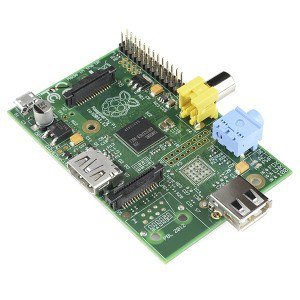 At IDR Solutions our developers spend a lot time working with our Java PDF Library and PDF to HTML5 Converter but sometimes we get to indulge in some side projects.
At IDR Solutions our developers spend a lot time working with our Java PDF Library and PDF to HTML5 Converter but sometimes we get to indulge in some side projects.
It made me consider whether it is worth updating to the Raspberry Pi 2 or whether there were other alternatives (even if they are less powerful).
So I thought it might be useful to compile a list of Raspberry Pi alternatives.
Raspberry Pi (1st Gen)
You might wonder why the Raspberry Pi has an entry in the top 5 picks. I guess it depends on your point of view. To me there are various models in the range so in one sense they are competing against each other.
The original Raspberry Pi was based on the Broadcom BCM2835 system on a chip (SoC), which includes an ARM1176JZF-S 700 MHz processor, VideoCore IV GPU, and was originally shipped with 256 megabytes of RAM. Later revisions of the hardware later upgraded (models B and B+) to 512 MB. The Raspberry Pi also came with SD support (models A and B) or Micro SD (models A+ and B+) sockets for boot media and persistent storage. Although running a single core when compared to the Quad core Raspberry Pi 2 there are currently plenty of existing projects that work on the Pi 1st Generation so if our looking to start of and not interested in the specs race it is a good place to start.
BeagleBone Black
The BeagleBone Black is a low-powered open-source hardware single-board computer similar to the Raspberry Pi produced by Texas Instruments. It was conceived with open source development in mind, and as a way of demonstrating the Texas Instrument’s hardware. The board comes with a AM335x 1GHz ARM Cortex-A8 with 512MB DDR3 RAM, 4GB 8-bit eMMC on-board flash storage, 3D graphics accelerator, NEON floating-point accelerator,2x PRU 32-bit microcontroller a micro SD slot, and a USB host port and multipurpose device port which includes low-level serial control and JTAG hardware debug connections.
ODROID
The ODROID is a series of single-board computers built and created by the Hardkernel Co Ltd an open-source hardware company located in South Korea. The name ODROID is derived from Open + Android however the hardware isn’t actually open source since the design righs is retained by the company. Primarily the ODROID systems are designed to be able to run the Android OS however they are also able to run Linux.
The ODROID-C1 is considered the entry point into the ODROID Family of single board computers.
Its current specification includes a Amlogic Cortex-A5(ARMv7) 1.5Ghz quad core CPUs, Mali-450 MP2 GPU (OpenGL ES 2.0/1.1 enabled for Linux and Android), 1Gbyte DDR3 SDRAM, Gigabit Ethernet, 40pin GPIOs, eMMC4.5 HS200 Flash Storage slot / UHS-1 SDR50 Micro SD Card slot, USB 2.0 Host x 4, USB OTG x 1, Infrared(IR) Receiver and can run Ubuntu 14.04 or Android KitKat.
However unlike the Raspberry Pi, ODroid-C1 requires a DC power supply through the means of a traditional jack.
Banana Pi
Banana Pi is often mentioned as a close alternative to the Raspberry Pi. It is a single-board computer made in China. It is flexible in that It can run Android, Ubuntu and Debian. Raspbian OS can also be run but the CPU complies it with the requirements of the Debian Armhf port instead. The Banana PI was designed to be an open source hardware platform which was created to assist the Elastos.org open source OS.
The Banana PI M2 is a quad core version of Banana Pi and a good alternative to the Raspberry Pi 2. The Banana PI M2 quad cored and has support for WIFI on board. It uses a 1Ghz ARM7 quad-core processor with 1GB DDR3 SDRAM, comes with aGigabit ethernet port, and one of the most mentioned points is that it can easily run 1080P high-definition video output (good if you are using it for home entertainment). It is GPIO compatible with the Raspberry Pi B+ and can run the ROM Image.
MinnowBoard Max
The MinnowBoard Max is definitely for the those who are looking for more spec however it will cost you a lot more than the alternatives listed here.
The MinnowBoard Max is powered by a 64-bit Atom processor, a version with a single-core 1.46GHz Atom E3815 with 1GB of DDR3 RAM is available, and a dual-core 1.33GHz Atom E3825 version with 2GB, both are 22nm parts with the code-name “Bay Trail”, and are clocked at 400MHz and the E3825’s at 533MHz in terms of Intel HD graphical support.
Although not a definitive list all of these alternatives have their pro’s and cons including pricing, specification, even community support (as the Raspberry Pi will have the larger community in comparison to the others), however in the end the choice of hardware is down to you and your needs.
Hopefully you found this short guide useful. Will you be upgrading?
If you are looking for some associated articles on the Raspberry Pi why not check out some of the articles which I previously wrote.
Top 8 IDE’s for Programmers, Coders and Beginners on the Raspberry Pi
6 Cool things to do with a Raspberry Pi over Christmas
We also covered some articles on the blog relating to the Raspberry Pi.
Remotely deploy projects to the Raspberry Pi using NetBeans IDE
Other Raspberry Pi articles
Our software libraries allow you to
| Convert PDF files to HTML |
| Use PDF Forms in a web browser |
| Convert PDF Documents to an image |
| Work with PDF Documents in Java |
| Read and write HEIC and other Image formats in Java |